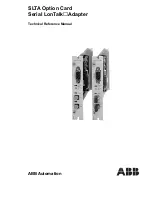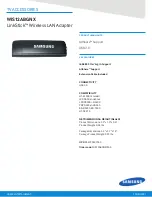
1MRS 750107-MUM
Serial LonTalk
Adapter
Technical Reference Manual
SLTA Option Card
ABB Automation
13
6.2.2.
Configuration of autobaud, baud rate and other communication
parameters
The S2 jumper group consists of 9 individual jumpers.
-XPSHU-
Is not used.
-XPSHU-
J2 defines the network interface link protocol to be used between the SLTA option
card and the host. There are two protocols available:
- Alert/Ack link protocol
- buffered link protocol.
The Alert/Ack link protocol is used with host devices that cannot accept
asynchronous streams of serial data at high speed, for example PC running DOS or
Windows. The buffered link protocol is used with devices accepting and buffering
back-to-back serial data without losing characters, for example, most real-time
operating systems, Unix, etc.
Factory default setting: Alert/Ack link protocol.
-XPSHU-
J3 determines whether the SLTA option card is to be used with a remote host or a
local host. If the card is connected to a host via a modem link remote state should be
selected. If no modem is used the jumper should be set for local host state.
Factory default setting: local state.
-XPSHU-
J4 specifies whether network communication is enabled or disabled after a reset. If
network communication is disabled then the SLTA option card enters into the
FLUSH state after reset. This means that the SLTA will not be able to communicate
on the network after reset. This will allow the host processor to get started without
receiving any messages from the network. To enable communication, the host must
send a niFLUSH_CANCEL network management message. If network communi-
cation is enabled the SLTA is able to start communication on the network
immediately after reset.
Factory default setting: disabled
-XPSHU-
J5 specifies the type of interface, i.e.3-wire or 8-wire, to be used with the RS232
connection. The 3-wire interface uses the TXD, RXD and GND signals of the RS232
serial interface. The 8-wire interface is used with a modem.
Factory default setting: 3-wire interface.










































